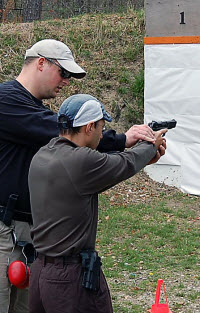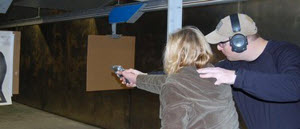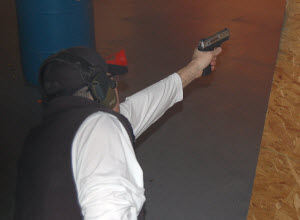An attribute is defined as a quality, character, characteristic, or property belonging to a person, thing, or group. In this article I’d like to discuss the essential attributes of the combative shooter, as I see them. Note I do not list accuracy or speed in my list of shooting attributes. While these are certainly desirable attributes for the combative shooter, they are not as important as mental conditioning, efficiency, consistency and practicality. Without these attributes, accuracy and speed may be attainable, but they won’t be reproducible under the duress and stress of a physical attack. If what you’re doing with your firearm is not reproducible when you need it, then it is not applicable to personal protection.
Metal Conditioning
1. Belief System
If you truly believe you will never have to defend yourself with a firearm, then you will never fully embrace and engage in the training required to become proficient. You may perform adequately at a training class or shooting event, but your skills will never reach the level required for you to perform on demand or under stress. In short, if you do not believe in the necessity of what you’re doing, you will never push hard enough, make the required sacrifices, or pursue excellence. Belief in the goal, dedication to the task and maximum effort build confidence. Confidence in yourself and the skills you possess differentiates those who are willing to act from those who are actors. The combative shooter believes in what he is training and the necessity for those skills.
2. Decision
The combative shooter has decided which path to follow. Occasionally shooting bulls-eyes at the range does not have a direct correlation to defending oneself with a firearm. Attending competitive shooting events requires skill, no doubt. Yet, inherent to all competitive events is an element of gaming that most who attend need to have if they want to win. The combative shooter’s goal is not to win a trophy, medal or title. It is to survive during a dynamic, life-threatening critical incident. Certainly, there are competitive shooters who are by no means easy prey, but they are the exception, not the rule. While target practice and competition help to build the combative shooter’s ability, understanding the difference between reality and square range drills shows them that competitive skills do not always carry over practically or tactically to combative shooting. The combative shooter has made a decision, has committed and continually works to develop a reproducible level of proficiency with personal protection as the ultimate goal.
3. Action
The combative shooter develops the necessary skills through dedication to the task at hand. As MMA fighter, coach and law enforcement officer Paul Sharp prescribes: Do your best to log 1000 hours of combative shooting training over your lifetime. Training one hour a week is only 52 hours a year, so 1000 hours is a considerable amount of time and requires dedication to your goal. Attending an eight-hour training class twice a year is not enough. Going to the range on Sundays and plinking cans is not enough. Will attendance at a weekend training class help push you toward that goal and impart skills? Sure, but remember that without practice, those skills are perishable.
Efficiency
Efficiency is the accomplishment of or ability to accomplish a job with a minimum expenditure of time and effort. What separates those who can shoot from those who are professional shooters are economy of motion and efficiency. Shooting is both a mental and a physical endeavor. Wasted movement is wasted time and, during a time-is-life encounter, being efficient is critical if you want to win, i.e. survive.
Being efficient means finding the best techniques, gun-handling procedures and methods that are effective and utilize the least amount of effort. Natural point of aim (NPA) is a good example. When shooting from any position, it is important we shoot from our NPA. To do anything less is to work against the muscles of our own bodies, which expends energy and induces fatigue. Neither are desired results during a life or death situation when time, energy and effort are precious and often fleeting commodities.
Consistency
Shooting is a complex set of events that require consistent practice to be mastered. If the gun-handling techniques chosen are not consistent, then efficiency, safety and ultimately survivability are all affected. Any precision- and time-oriented physical task requires consistency in order to perform the task repeatedly on demand.
Take, for example, trigger manipulation. If the trigger of a firearm is not manipulated consistently in the same manner for each shot, then each shot may in fact strike the target in a different location. Or if the handgun is held in a different position each time an emergency reload is required, the mind and body will waste time searching. Focus will come off the threat and aid in the search for the gun to assist in the reload procedure. This wasted time and redirection of threat focus could mean the difference between life and death.
For some combative shooters, such as members of law enforcement, military or security forces, proficiency with multiple weapon platforms is required. Combative shooting skills should share features and characteristics or possess consistent attributes from one firearm to the next. It should be the goal of every combative shooter to perform certain firearm manipulations the same way when using a pistol, carbine or shotgun.
If a different technique is required to combatively handle each firearm, then our ability to make decisions during stressful situations and therefore to take action is slowed. If consistency and commonality exist, then decisions are accelerated, since the technique is the same for one firearm as it is for another. Examples include platform, loading/reloading procedures and malfunction clearance procedures.
If a different shooting platform is utilized for each firearm, efficiency suffers. If a different loading position and procedure are used for the pistol than the carbine and shotgun, then that is inefficient. Commonality of skill sets across firearm platforms develops a more efficient combative shooter and limits the decisions that need to be made under stress.
Practicality
Study personal protection shootings via the NRA’s Armed Citizen reports and the FBI’s Law Enforcement Officers Killed & Assaulted reports, read about historical shootings, and debrief individuals who have been involved in shootings. All of these aid in determining what skills are most practical and necessary for the combative shooter. Training in varied weather conditions, with varied target systems and training aids is also essential.
Without this practical validation process, most of what a shooter does on the range is anecdotal and sometimes speculative. The combative shooter prepares for realistic situations and trains in the most practical manner possible.
Conclusions
What makes a combative shooter different from any other person who shoots? The word “combative” illustrates the shooter’s mindset: thinking combatively represents a proactive mindset. Having a combative mindset does not mean you’re looking for trouble or a fight. It means that a decision has been made that when trouble or potential harm is imminent, the combative shooter would rather act first versus thinking defensively and waiting to react to the aggressor.
If you make a decision to train for personal protection, it is imperative that you believe in what you’re training and know why you’re training it. Strive to become efficient, consistent and practical when you’re shooting, and you’ll be on the right path toward combative shooting proficiency for personal protection.





My spouse and I stumbled over here from a different web page and thought I might check things out. I like what I see so now i'm following you. Look forward to looking into your web page for a second time.
To be a true combative you need more then just be able to use the gun. You need in your tool box the skills with empty hands, impact weapons ( can be anything phone, pan, chair etc.), knives, non-lethol weapons etc. It is more then just the gun to train with, yes you have to be mental prepare and that includes other areas besides the firearm.
Great
Fantastic article. I have had the pleasure of training with Chris and find him to be on the "cutting edge." I wholeheartedly recommend his articles and training to all.
Great article. I would definitely recommend this read to others.